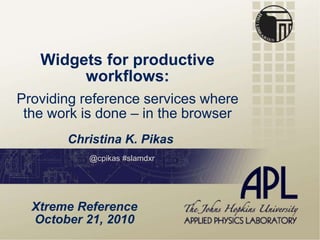Pikas xtreme reference 2010 final
- 1. Widgets for productive workflows: Providing reference services where the work is done ¨C in the browser Christina K. Pikas Xtreme Reference October 21, 2010 @cpikas #slamdxr
- 2. You are free to: Copy, share, adapt, or re-mix; Photograph, film, or broadcast; Blog, live-blog, or post video of; This presentation. Provided that: You attribute the work to its author and respect the rights and licenses associated with its components. şÝşÝߣ Concept by Cameron Neylon, who has waived all copyright and related or neighbouring rights. This slide only ccZero. Social Media Icons adapted with permission from originals by Christopher Ross. Original images are available under GPL at; http://www.thisismyurl.com/free-downloads/15-free-speech-bubble-icons-for-popular-websites
- 3. Agenda ?Background and basis ?Strategies ?Examples ?Marketing ?Discussion Widgets for Productive Workflows3
- 4. Background ?Lots of recent research reports on how scholars work online (Palmer et al, Harley et al, Proctor et al) ?Other information on how people locate ? Recreation or hobby information ? Health information ? Job information ?Information on how people socialize online Widgets for Productive Workflows4
- 5. Generalities ?People like Google, but they donˇŻt use it well ?Libraries and librarians have things that will help, but users donˇŻt know about them or how to use them ?Even true library fans satisfice when looking for information ? To save time or money ? To not interrupt their work Widgets for Productive Workflows5
- 6. The Idea ?Integrate library services where, when, and how they are useful ?Base decisions on evidence and best guesses ?Use freely available tools as much as possible Widgets for Productive Workflows6
- 7. Strategy ?Know your users ? What are their tasks? ? What are their environments? ? Where are their pain points? ? What frustrates them? ?Know what help you can provide and what you do well ?Try something, evaluate it, and then fix or ditch it Widgets for Productive Workflows7
- 8. What can be done in the browser? Widgets for Productive Workflows8 8 Toolbars and bookmarklets Search Status bar
- 9. Widgets for Productive Workflows9 Right click menus
- 10. Example 1: The LibX Toolbar ?The need ? Use the power of Amazon to identify interesting books, but locate a library copy ? Find articles in Google, but authenticate to use the libraryˇŻs subscription ?The tool ? Built by Virginia Tech, itˇŻs freely available ? Customize it for your users and your tools ? http://libx.org Widgets for Productive Workflows10
- 11. Widgets for Productive Workflows11 Also adds cues to Wikipedia and other places and hyperlinks ISBNs, ISSNs, DOIs, and PMIDs
- 12. 12
- 13. 13 Links to library web pages Select which fields to search Add additional fields Search the catalog or Google Scholar Drag text over this to search for that text in Google Scholar
- 14. Example 2: Search box searches ?The need ? Search authoritative sources as easily as web search engines ? Highlight information on the page and search for that ?The tool ? Works easily in Internet Explorer and Firefox ? Premade ones from your vendors ? Specification is freely available 14
- 15. Widgets for Productive Workflows15
- 17. How? Easiest way: ?Use Internet ExplorerˇŻs tools to create your own http://tinyurl.com/2jtlva ?Swipe the XML for Firefox ?Use the instructions from the specification or from http://tinyurl.com/3xrbwyf ? Make it available as a link ? Make it autodiscover 17
- 18. Widgets for Productive Workflows18
- 19. Widgets for Productive Workflows19
- 20. Plusˇ if they have the context search plugin, they can then launch searches from wherever, after highlightingˇ Widgets for Productive Workflows20
- 21. Widgets for Productive Workflows21
- 22. Example 3: Bookmarklets ?The need: ? See if something is in the library ? Add something to your citation manager ? Make note of something ?The tools: ? Bookmarklets are javascript that sit in your links bar ? They take information from what you highlighted and submit it to a web form ? Like Amazon book info or citation info Widgets for Productive Workflows22
- 23. Some library-type bookmarklets ?Add to Zotero, Add to Refworks, etc. ?Library Look Up ?EZ Proxy Reload Widgets for Productive Workflows23
- 24. Marketing ?Browser plug-ins are still a tough sell, even when you demonstrate them ?Autodetect for search will work for some people who a) use the search block, b) notice it, and c)want to search your stuff ?Looking for additional solutions! Widgets for Productive Workflows24
- 25. Summary ?There are lots of ways to help your user while they complete their tasks by adding to their browser ?Start by figuring out what will help them ?Use open tools ?If you figure out the best way to market these, please let me know! Widgets for Productive Workflows25
- 26. Contact Information Christina K. Pikas, BS, MLS The Information Group The Johns Hopkins University Applied Physics Laboratory Voice 443.778.4812 (Baltimore) 240.228.4812 (Washington) E-mail Christina.Pikas@jhuapl.edu Blog http://scientopia.org/blogs/christinaslisrant
- 27. Resources ? http://www.libsuccess.org/index.php?title=Web_Browser_Extensions ? Aaron TayˇŻs blog http://musingsaboutlibrarianship.blogspot.com/ ? Harley, D., Acord, S. K., Earl-Novell, S., Lawrence, S., & King, C. J. (2010). Assessing the future landscape of scholarly communication an exploration of faculty values and needs in seven disciplines. Berkeley, CA: Center for Studies in Higher Education, UC Berkeley. Retrieved from http://www.escholarship.org/uc/item/15x7385g ? Palmer, C. L., Teffeau, L. C., & Pirmann, C. M. (2009). Scholarly information practices in the online environment: themes from the literature and implications for library service development. Dublin, Ohio: OCLC Programs and Research. Retrieved from http://www.oclc.org/programs/publications/reports/2009-02.pdf ? Proctor, R., Williams, R., & Stewart, J. (2010). If you build it, will they come? How researchers perceive and use web 2.0. London: Research Information Network. Retrieved from http://www.rin.ac.uk/system/files/attachments/web_2.0_screen.pdf ? Open Search specification: http://www.opensearch.org/Specifications/OpenSearch/1.1#OpenSearch_descrip tion_elements ? Tool to create search plugins: http://www.searchplugins.net/generate.aspx# ? Library Lookup generator (no Polaris yet!) http://207.22.26.166/LibraryLookupGenerator.html ? EZ Proxy bookmarklet generator http://blog.philipwolstenholme.com/2010/02/log- in-to-ezproxy-one-click-ezproxy-bookmarklet-generator-library-university/ 27



























